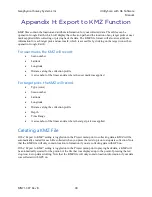
Geophysical Survey Systems, Inc.
UtilityScan with GS Software
Manual
MN71-307 Rev B
26
Depth:
This option is only visible if the vertical scale is set to depth. Changing depth will change your
depth of investigation by changing the time range (hidden). Depth accuracy is dependent on correctly
setting the dielectric value.
Surface (%):
Surface (%) refers to the position of the viewable scan with respect to the antenna’s direct
wave. The direct wave is the first instance of the receiver seeing the transmitted signal and corresponds to
the ground surface. There may be situations when you want to view a portion of the scan before the direct
wave. Shifting the surface % in the negative direction will move the direct wave farther down the
window. The Surface (%) value entered represents a percentage of the full time range. For example,
entering a value of -10 while collecting with a time range of 100ns will shift the direct wave down by 10
ns.
Scans Density (Scans/Meter or Scans/Ft):
This refers to the number of scans collected within a unit of
distance. This option is only visible if the collect mode is set to distance. Increasing your scan density will
result in more scans being stacked next to one another and therefore causes the data to be exaggerated on
the horizontal scale. A lower scan density will cause the data to appear more horizontally condensed.
Samples/Scan:
Each scan trace is made up of individual samples. You can think of samples as the
“dots” that make up a “line.” Samples are collected along each scan recorded by the antenna’s receiver.
The amount of samples/scan can affect your vertical resolution, as the number of samples essentially
represents the number of datapoints collected along each scan. Inputting a Samples/Scan value that is too
low risks recording a signal with poor resolution. Inputting a Samples/Scan value that is too high will
result in slower collection and larger files sizes for no practical benefit. For a 350 MHz antenna the
default sampling rate is 1024 samples per second.
Scans/Second:
Refers to the maximum number of scans each second that are available to record. This
value is the functional limit of your collection speed and should be set as high as possible. It will vary
according to the interplay of your samples/scan and transmit rate.
Scans/Point:
This option is only visible if the collect mode is set to point. This parameter controls the
number of scans collected and averaged into a single recorded scan at each given shot location. The
higher the number, the more averaging that takes place. More averaging, if subsurface conditions permit,
may result in deeper penetration.
Содержание UtilityScan 50350HS
Страница 1: ...MN27 151 Rev A MN71 307 Rev B ...
Страница 4: ...Geophysical Survey Systems Inc UtilityScan with GS Software Manual ...
Страница 6: ...Geophysical Survey Systems Inc UtilityScan with GS Software Manual ...
Страница 8: ...Geophysical Survey Systems Inc UtilityScan with GS Software Manual MN71 307 Rev B 2 ...
Страница 14: ...Geophysical Survey Systems Inc UtilityScan with GS Software Manual MN71 307 Rev B 8 ...
Страница 20: ...Geophysical Survey Systems Inc UtilityScan with GS Software Manual MN71 307 Rev B 14 1 2 3 4 ...
Страница 46: ...Geophysical Survey Systems Inc UtilityScan with GS Software Manual MN71 307 Rev B 40 ...
Страница 47: ...Geophysical Survey Systems Inc UtilityScan with GS Software Manual MN71 307 Rev B 41 ...
















































